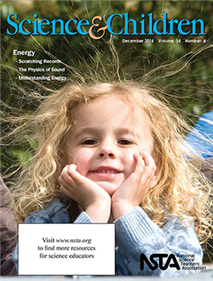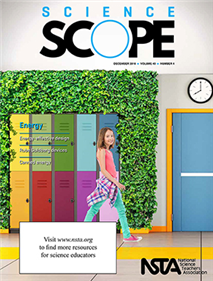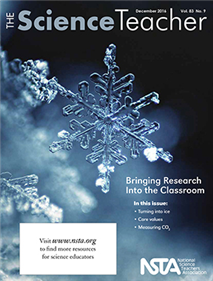All Resources
Journal Article
Third graders explore static electricity with latex-free supplies....
Journal Article
Using a learning center to promote STEM development in early childhood....
Journal Article
Fourth graders use physical and technological models to illustrate and explain the nature and characteristics of sound....
Journal Article
Using multimedia circuits to teach electricity in elementary school....
Journal Article
Editor's Note: Teaching Energy Is Compelling
Science and Children’s editor shares thoughts regarding the current issue....
Journal Article
The Early Years: Preparing for Spring Gardening
This column discusses resources and science topics related to students in grades preK to 2. This month’s issue helps students build an understanding of the effects of the Sun’s radiation on the surface of the Earth through hands-on gardening....
Journal Article
Teaching Through Trade Books: The Sounds of Science
This column includes activities inspired by children’s literature. This month’s issue features activities that engage students in qualitative investigations as they make observations about sound and how it travels....
Journal Article
The Poetry of Science: Light and Sound
Building literacy in playful, meaningful ways. This month's issue discusses sound....
Journal Article
Science 101: What’s Really Going on in Electric Circuits?
This column provides background science information for elementary teachers. This month’s issue discusses how electric circuits work....
Journal Article
Methods and Strategies: Claims and Evidence
This column provides ideas and techniques to enhance your science teaching. Learn how to create opportunities for students to practice speaking and writing about science....
Journal Article
Engineering Encounters: Robots, Bookmarks, and Guitars, Oh My!
This column presents ideas and techniques to enhance your science teaching. This month's issue discusses fusing art and design into an upper-elementary electricity unit....
Journal Article
Designing and Building a Rube Goldberg Machine to Contextualize a Unit on Energy
Explore the conservation and transfer of energy by building a device that completes a simple task....
Journal Article
I Get It! Moving Students From Misconceptions to Conceptual Change
Move students toward deep, accurate scientific understanding using the conceptual change model....
Journal Article
Design an Energy-Efficient House: Applying Multidisciplinary Knowledge to Solve a Design Challenge
Can you keep a house warm while avoiding high energy bills?...
Journal Article
Food and Energy for All: Turning a Demonstration Into an Inquiry Activity
Explore the reactants of photosynthesis to explain that they are raw materials and not food....
Journal Article
From the Editor's Desk: Tapping Into Energy
Science Scope’s editor shares thoughts regarding the current issue....
Journal Article
Classic Lessons 2.0: The Come Back Can
This column shares updated perennial classroom favorites.This article describes a science activity that can be used to demonstrate the law of conservation of energy. The activity involves inquiry and problem solving using a Come Back Can....
Journal Article
Citizen Science: Power Up Science Learning With NOVA’s Energy Lab
This column highlights formal and informal science research projects that students can join and contribute to by gathering and sharing data. This month's column will help teachers transform science learning from passive to active and spark student in...
Journal Article
Disequilibrium: A Human Circuit
This column shows how to use discrepant events to confront misconceptions. This month’s discrepant event involves creating a human circuit using gadgets....
Journal Article
Listserv Roundup: Getting Smart With Energy
This column shares recent conversations taken from the NSTA listserv community about current science education topics. NSTA's Physical Science listserv members recently discussed information about energy and its different forms, with conversations ab...
Journal Article
Science for All: Empowering Students Through Collaboration
This column shares strategies for increasing student engagement. This month's column provides strategies for grouping students to increase their productivity, accountability, engagement, and performance levels, while still providing them with the lev...
Journal Article
Teacher to Teacher: Predicting, Explaining, and Observing Thermal Energy Transfer
This column provides practical advice from your peers. This month's columnn discusses using the Mixing Water formative assessment probe from Uncovering Student Ideas in Science, Vol. 2 to determine student thinking regarding thermal energy transfer a...
Journal Article
Scope on the Skies: Studying Rings Around the Sun
This column focuses on astronomy throughout the year. This month’s issue discusses asteroids and moons....
Journal Article
Students learn firsthand how thawing permafrost adds to global warming....
Journal Article
Building paper chromosomes to help understand five key terms in genetics....
Journal Article
Editor's Corner: Authentic Science Practices
The Science Teacher’s editor shares thoughts on the current issue....
Journal Article
Commentary: Proactive Leadership
An opinion piece about how reform in science education is appearing on multiple fronts....
Journal Article
Science 2.0: Developing the Knowledge Constructor
This column shares web tools that support learning. This month’s issue discusses the ISTE’s Knowledge Constructor standard....
Journal Article
Focus on Physics: How E = mc2 Helps Us Understand Nuclear Fission and Fusion
This column helps teachers build an understanding of physical principles. Nuclear physics has an undeserved reputation for being tough for students. This article may reduce this “toughness” by showing how Einstein’s familiar equation E = mc2 re...
Journal Article
Health Wise: Keeping Track of Sugar
Students study sediment cores to learn about climate in the past. Students learn how to read Nutrition Facts labels to learn how much sugar is in a food item....
Journal Article
Career of the Month: Interdisciplinary Technologist
This column shares interviews with professionals using science in the workplace. This month’s issue describes George Church's career path to becoming an interdisciplinary technologist....





